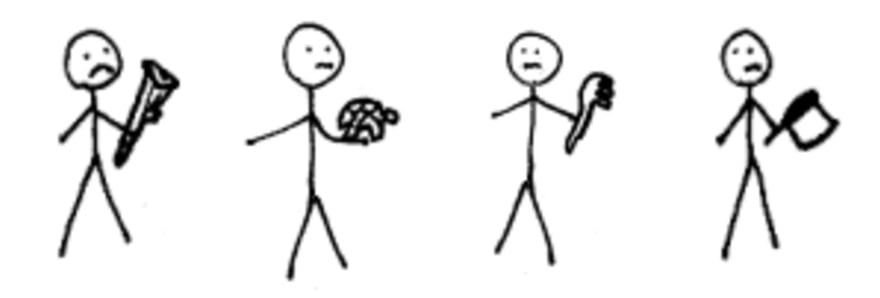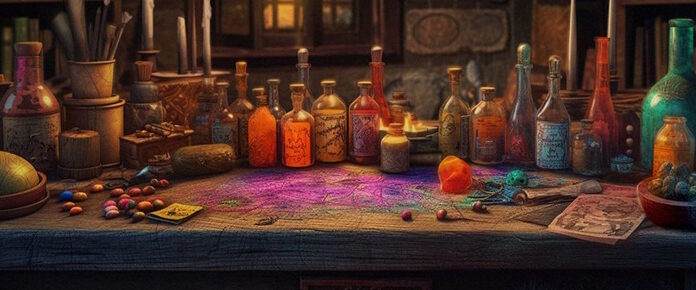
It is, in so many ways, the antithesis of a modern MMORPG. It has crude stick figure drawings instead of lush 3-D graphics. It limits your daily activities to a handful of encounters. It often mocks, belittles and berates you for your stupidity. It uses meat for currency and has a character class that dabbles in pasta-based magic. It’s been in open beta for the better part of a decade now. And its endgame is actually an end-of-the-game instead of an eternal raiding grind.
I speak, of course, about Kingdom of Loathing, one of the oddest online RPGs on the net — and one of the most beloved. When I mulled over the game for this month’s retrospective, I found myself really wanting to talk about KoL but a little unsure whether it truly belongs in the pantheon of accepted MMOs. At best, it’s on the fringe; while you do play in a world populated by hundreds, if not thousands, of other players at any given time, it’s mostly a solo exercise apart from the chat channel. However, it is a persistent world, it does hold many of the trappings of MMORPGs, and the creators have come up with clever ways for players to interact within a turn-based RPG. I’m also a huge fan, having dabbled in KoL off and on for years now, and I love recommending it to friends.
So what the heck — we’re doing it. Kingdom of Loathing is a great success story in its own right and has a lot to teach the rest of the MMO industry about unconventional methods of structuring and presenting these games. Hit the jump and we’ll run down eight highlights that separate KoL from the rest of the pack and make it a game well worth your spare time.
A Low-fi multiplayer adventure
Kingdom of Loathing’s genesis came about in 2003, when bored IT worker Zack “Jick” Johnson wanted to make a “low-fi multiplayer web game” that wasn’t strictly about PvP — and was silly to its core. He whipped up the prototype of this title in a week, released it to the world, and was overwhelmed by how popular it became. Following that, Johnson hired staff and took a project that was, by his own admission, “primarily a joke” and turn it into a full-featured game. He teamed up with childhood friend Josh “Mr. Skullhead” Nite, who remained with on staff until 2014.
Irreverence for the genre
Kingdom of Loathing’s tagline — “An adventurer is you!” — is your first and best indication of what to expect in the game: It’s a realm full of obscure references, bad puns, clever wordplay, and a cheeky attitude. Adventurers are invited to take on the role of one of six classes (there are two melee, two rogue-types, and two magic-users) and set out in the Kingdom of Loathing to work their way up to an epic confrontation with the Naughty Sorceress, who has kidnapped the king. Along the way, players will have to accumulate wealth, build up a truly epic inventory, solve tons of puzzles, and explore so many nooks and crannies that even grannies lack these crannies.
Every day, players receive a set number of “adventures” that are expended through various actions, usually via combat and exploration. You can increase the number of these adventures typically by eating food and drinking alcohol — although you have to be careful not to get too drunk, as that may end your day’s adventures prematurely. Combat is a turn-based affair of back-and-forth blows, although spells may be cast, buffs applied, and unusual items put into play at opportune times. Get killed, and you’ll be spending a handful of precious adventures healing up.
At its core, KoL is about tweaking the RPG and MMO genre’s nose and having great fun by reversing expectations and using the ridiculous (such as using meat as currency instead of gold or platinum) to highlight the tropes we’ve long since become accustomed to experiencing. It’s adventuring with tongue firmly in cheek and sarcasm flying overhead as your battle standard.
The funny
More than anything else, Kingdom of Loathing comes off as a shameless stand-up comedian who has an intimate knowledge of pop culture. If you dig bad puns, movie references, insanely clever wordplay, silly back-and-forth dialogue, and general goofiness, this should be homecoming for you. At every turn, KoL wants to make you laugh and brings the funny and punny big-time, from the quirky drawings (which add a lot more atmosphere and charm than you’d initially suspect) to themed locales like the Misspelled Cemetary, the Orc Chasm, and the Haiku Dungeon.
Puzzles upon puzzles
It’s not all about just bashing monsters with big rocks until blood, brains and precious loot falls out — I mean, that’s a big and gross part, to be sure, but KoL goes far beyond that. In fact, the core gameplay really revolves around a staggering amount of puzzles and challenges. Sometimes the tasks are spelled out for you in advance, but most of the challenges you face will be self-imposed: You’ll see something you need or want and then try to figure out how to get there or accomplish it.
Here, the game shines with ingenuity, often requiring a lot of experimentation, item combining, and poking around to solve puzzles. While the lay of the land may look small at first glance, there’s so much packed into these areas (and more added all the time) that I’ve never run out of things to do or achieve. One day, I might be trying to assemble my meatcar through a long and intricate collection quest, and another day I could be hunting down an animal that only comes out under very special circumstances. If you’ve bemoaned how mindless MMOs have become and want a mental workout, Kingdom of Loathing is right up your alley (just don’t rely on TheKolWiki too much, as it spoils a lot of the secrets and fun that come with exploring).
Players must be this literate to chat
KoL players pride themselves on being a cut above the grammatical mishmash that is the typical MMO chat channel, which makes sense in a game that’s completely dependent on the English language. In fact, before you’re even allowed to spew brain-farts into general chat, the game requires that you pass a literacy test that hopefully weeds out those who haven’t quite figured out that “you’re” and “your” are completely different words. On top of this, moderators police the chat channels for rogue idiots, often silencing them for hours or days depending on the severity of their crime.
Setting a higher standard for language and its use means that you are assured a better chat environment than normal, and that makes a surprising difference in the enjoyment of the game. And I can’t say I know any other game that actually boasts a haiku chat channel for folks who really want to socialize poetically.
Useful clan housing
Joining a clan in KoL is not only recommended but practically required. It’s helpful to have the support of much more experienced players, and the clan hall is one of the best resources in the game. Among the various rooms and functions is the Rumpus Room, which the clan can deck out with various useful items. Depending on the decorations, clan members can be treated to additional adventures per day as well as items and health restoration that they wouldn’t get otherwise.
Social activities abound
So far, Kingdom of Loathing sounds a lot like a single-player experience, mostly due to the limitations of the format if nothing else. However, the creators came up with a couple of interactive solutions that keep everyone from being an island unto himself.
There’s a thriving economy in KoL — players can set up their own stores and watch their meat storehouses fill with wealth. If you’re looking for PvP, it does exist in the game, but probably not the way you’d think. PvP is completely optional and involves players engaging in minigames (such as a pie-eating contest) when they attack each other’s campsites. Finally, some of the dungeons involve a group of players instead of just one, including the 2008 raid expansion, Hobopolis.
A pet to call your own
No matter which class you pick, all players have access to pets, called “familiars.” There are well over a hundred familiars in the game, and each helps you out in a special way — from attacking alongside you to increasing the loot drops to adding to your daily adventures. You aren’t stuck with just one familiar but rather can collect and swap them at will as well as level them up. Everyone has his favorites, but I’d have to say that Ninja Pirate Zombie Robot is probably the most notorious — and sought-after — pet of the bunch. He gives you toast! Well, sometimes.
Ascension
If I had to pick one thing that sets this game apart, it would probably be the Ascension system. Basically, Ascension is a way to encourage players to re-roll characters instead of continuing to wallow in the endgame indefinitely (although some players choose not to ascend and to participate in other activities instead). Once the main quest line is complete, players have the option to ascend to the afterlife — Beyond the Pale — where they can dither about in the heavens for a bit before returning to the game as a new character.
The benefit of ascending is that new players are given set of special rewards for use in their new game, and these rewards are increased if a player has voluntarily chosen a more difficult path to ascension in the previous game (such as avoiding alcohol). Players get to keep most of their items and meat (all of which is usually locked away in a vault for a set amount of time) for the next game as well, giving them a leg up. It’s not uncommon to see players who’ve undergone multiple ascensions — even well into the double-digits — as they pursue these unique rewards.
Going West of Loathing
In 2017, developer Asymmetric took the art style, humor, and general theming to a new setting with West of Loathing. This single-player RPG was to open world RPGs as Kingdom of Loathing was to MMOs. The “weirdest west” game proved to be a big hit for the studio and spawned a DLC and several platform versions.
 Believe it or not, MMOs did exist prior to 2004! Every two weeks, The Game Archaeologist looks back at classic online games and their history to learn a thing or two about where the industry came from… and where it might be heading.
Believe it or not, MMOs did exist prior to 2004! Every two weeks, The Game Archaeologist looks back at classic online games and their history to learn a thing or two about where the industry came from… and where it might be heading.

















